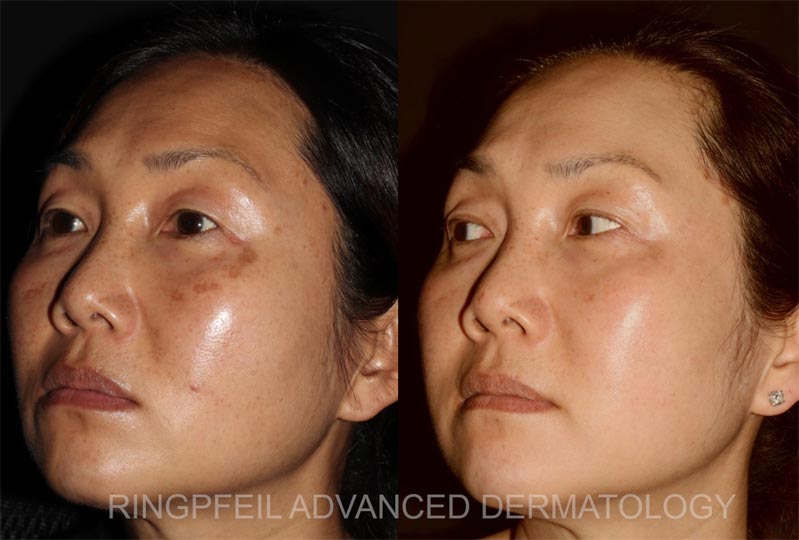Sun Damage - Patients ask, Dr. Ringpfeil answers
Please feel free to use the blog below to share information about Sun Damage or to ask Dr. Franziska Ringpfeil a question that might be of interest to others.

| Treatment Area | Price | Sessions |
|---|---|---|
| Spots | $105 for the 1st spot | $20 for any additional spot |
| Face | $400 | 1-3 treatments needed |
| Neck | $300 | 1-3 treatments needed |
| Chest | $500 | 1-3 treatments needed |
| Shoulders and Arms | $500 | 1-3 treatments needed |
| Forearms | $400 | 1-3 treatments needed |
| Hands | $300 | 1-3 treatments needed |
| Legs | $500 | 1-3 treatments needed |
Treatments: Surgical removal, alexandrite laser, Plasma, Fraxel laser, Erbium Pixel, CO2 laser, IPL.
Solar lentigos are often referred to as sun or age spots. They may occur in all sun-exposed areas and result from UVA exposure. Many treatments are available to remove them from the skin without scarring.
Treatment regimens are tailored to your skin and also depend on other problems that are desired to be correct



I’ve had a pretty stubborn scar from an excessive use of face serums for months now. My skin had dried off and started peeling off, leaving me with a big scar. I’ve tried different face creams and serum but I haven’t seen a significant improvement, do you have any recommendation about treatments I should be looking into?
I suspect that you refer to pigment changes of your skin which is called scarring by many laymen. The most common pigment change is skin darkening in response to irritants or photo-enhancers (e.g citrus).
Sun protection with a mineral based sunscreen that you reapply every 2 hours when outdoors is the most important measure to reduce ongoing pigment formation. You should stop the serum that has darkened your skin and force hydration with hyaluronic acid containing moisturizers twice daily. There are many common brands that sell hyaluronic acid creams, gels or sera.
Scars are defined as permanent and they result from skin breakdown between its 2 top layers, the epidermis and the dermis. I would lie to assure you that this permanent state cannot be achieved with over the counter face sera. If you developed blisters in response to a facial serum and you developed a true scar at the site of the blister(s), please schedule an appointment with your dermatologist.
Hello. I’m an established patient at your Bryn Mawr office. I’ve had sclerotherapy done several times on my legs and the treatments were successful. I do have a history of hemosiderin staining which usually fades away. I have two small spots that have not faded over the course of a year. Years ago I did a TCA peel at home which worked very well. I do understand the dangers of this and would only consider professional treatment going forward. I was curious to know what type of appointment I should make at your office and what the treatment options are. Thank you
The most common side effects of sclerotherapy are post inflammatory hyperpigmentation due to melanin leakage into the skin overlying the inflamed blood vessels, matting, and blue coagula of blood inside vessels that were sclerosed. Post inflammatory hyperpigmentation usually resolves by 3 – 6 months. TCA helps skin turn over and lifts trapped melanin in the epidermis from an inflammatory process. TCA peel for epidermal pigment has largely been replaced by the more predictable and precise picosecond laser treatment. If you have already been evaluated for the dark stains by our dermatologists, please send me a portal message or text the office at 610-525-5250. If not, you may schedule a complimentary evaluation with one of our aestheticians to learn if picosecond laser treatment is appropriate.
Hemosiderin staining is a rare side effect of sclerotherapy. Picosecond laser treatment has also the best record to clear hemosiderin stains because it can safely reach into the dermis, the second layer of the skin, where it shatters the large hemosiderin molecules into small fragments so that our body can clear these naturally.
Hello,
I have had freckles all over my chest, shoulders arms and back since I was little. My stomach, legs, and face are creamy smooth with no freckles, spots or moles. I am not concerned with the moles on my back, I am concerned with the freckles on my arms, shoulders and upper chest/neck.
I spent $1,200 at a dermatologist in Center City Philadelphia with no result. They used IPL. They agreed that there were no results, they were shocked, they had said they thought the treatment would work “beautifully” on me, I have very pale skin.
They tried several different lasers at different strengths etc. Nothing worked and I felt awkward in showing up over and over again so I just stopped trying with them. I have read your other responses and see that spots on the body may be more difficult to treat than spots on the face. Is there any hope for me? Would you perform a “test” spot before treatment to confirm it would, indeed work?
Given the history of 3 unsuccessful IPL treatments as well as several failed distinct laser treatments, review of all treatments parameters is essential in planning any next step and to determine if treatment is possible. If you wish to get ahead, please schedule a cosmetic telehealth visit with me and forward all treatment records for review prior to this appointment. If treatment is possible, we will schedule complimentary test spots when the COVID 19 crisis is over.
I have post inflammatory Hyperpigmentation (PIH) on legs and arms. I am african American (Fitzpatrick V). Do you have a laser to remove PIH?
Post inflammtory hyerpigmentation on the face, chest and back can usually resolve with treatment, but it is not easy to remove post-inflammatory hyperpigmentation on arms and legs, and there is no specific laser for this task.
Picosecond lasers often afford treatment possibility for stubborn hyperpigmentation on extremities. These types of lasers are colorblind and can safely be used on all skin tones. When we use we also assure that the process must be accompanied by meticulous sun protection (sun protective clothing or broad-spectrum SPF>30), fading agents including kojic acid, lactic acid, glycolic acid or azelaic acid and by vigilant hydration of skin. You may schedule a complimentary consultation with one of our aestheticians to find out if you are a candidate.
I have like 5 to 6 times darker inner thigh and buttocks compared to my face. Can laser treatment correct it n bring it closer to my other body skin.
Darkening of skin occurs on inner upper thighs and buttocks occurs with repeated friction. Removal of friction removes the darkening. There are no known other remedies.
I’m 50, have very pale skin and have up to 1cm wide brown spots (from sun exposure) on my legs and forearms. My lower legs are my main concern. I had an expensive series of IPL with zero results. I’ve tried 4 treatments of 12.5% tca (2-3 layers each treatment) with zero results even though I peeled a lot. Once I had salicylic acid of unknown strength on one spot that worked very well (it burned/left area pink for a few weeks so seemed pretty strong). I had a spot frozen on my face that was 100% effective and not uncomfortable like the tca is. I don’t mind discomfort if it works. Can I have my spots reduced/removed on my legs by freezing? Or is there another treatment that would actually work, even if my spots are very resistant or deep? (I have never had my spots treated at Ringpfeil, and just to exclude the question, yes I’ve used sunscreen throughout all treatments; I wear it every day all over my body, even indoors). Thank you!
Sun spots on the legs are much harder too remove than on the face. Freezing is an option considering the failure of the other methods, yet success on the face does not constitute the same on the legs. Cryosurgery can leave the skin lighter than the surrounding. In this scenario, you should aim to treat one spot first, see if and how it responds, and only proceed with treatment of others after 6-8 weeks if you are happy with results.
Hello Dr. Ringpfeil,
I have a medium dark skin tone and suffer from post-inflammatory hyperpigmentation from blemishes. What would be the best treatment to get rid of my brown spots? Peel, laser, or cream (I am currently using Differin because I don’t want to use hydroquinone)? In the past, I got some brown spots when I used the retin-A that never faded.
I have two cafe-au-lait macules on my leg and my stomach that I also want to get rid of. Would laser treatment be the best option?
Best regards,
Melissa
This blog format addresses general concepts. An in-person consultation would be most appropriate to address your very specific concerns.
I have acne scarring hypo pigment from laser and the previous acne. I also have some melasma.
Please schedule a consultation at our office.
Dear Dr Ringfeil,
I am an Asian (Fitz IV -V) in my mid-forties with freckles. I have tried long pulse Alexandrite with good improvement, but then after a few years (about once a year visit) seemed to stop making a difference.
Please can you let me know if you have a recommendation?
Thanks very much.
Y
You might try the Picosure Focus Lens.
Hello,
I am a 45 year old Asian woman and I have hori’s nevus on my cheeks and nostrils. I also have melasma on my cheeks and forehead/temples. I have read that a Q-Switch ND Yag Laser 1064 nm or picosure laser could help fade this. I have used the melanage peel twice and have used the jessner peel twice as well (both a few years ago). The melanage peels made the melasma on my temples worse. The jessner peels did nothing to fade the discoloration. Have you had success with either of these laser for my issues? and what would be the cost for the entire face?
Thank you.
Both lasers can treat Hori’s nevus. The picosure laser can treat both Hori’s nevus and melasma. Both conditions will need several treatments at least 6 weeks apart. And both can be treated at the same time.